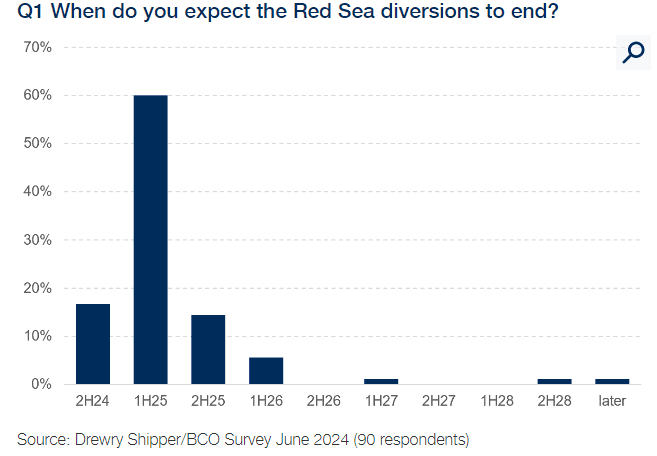Ocean container shipping costs have been rising rapidly on many lanes, and the maritime analysts at Drewry see four key factors in the jump.
Drewry says some shippers are having issues securing capacity at agreed contract rates, as carriers reserve capacity to currently more profitable spot market shippers.
Supply Chain Digest Says... |
 |
|
| Of the four factors causing the current capacity and efficiency issues, only some look to last longer than a year, Drewry states. |
|
 |
|
What do you say? |
|
| Click here to send us your comments |
|
| |
|
| Click here to see reader feedback |
|
|
|
The Drewry World Container Index, a weighted average of spot rates on eight East-West routes, had declined steadily from $3,964 per 40-foot container in January to just $2,705 in late April, as carrier networks appeared to settle down after the start of Houthi rebel Red Sea attacks on cargo ships.
However, spot rates then soared 74% between late April and early June – on top of which, Drewry says “we know from shippers that many are asked to pay peak season surcharges.”
In a recent blog post, Drewry says it has identified four causal factors behind the recent challenges for shippers. They are:
Stagnant Capacity
Drewry says the data show that carriers have added many ships into their East-West services to compensate for the longer routes now used by nearly all the former Suez Canal-dependent carriers abandoned with the Red Sea danger.
However, Drewry says, this seemingly large addition of ships resulted in only a 2% increase in the monthly effective capacity per month, to 1.1 million TEU, because these assets are now sailing over longer distances and are less productive than before the Red Sea attacks started.
The coming good news for shippers: Drewry estimates that the remaining capacity due to be delivered during 2024 will finally have an expansionary effect on effective capacity, not just a repeat of merely correcting the need for more ships after the Red Sea diversions.
Very Strong Demand Growth
While data for May is still sparse, it is clear that transpacific volumes and volumes on several other routes are stronger than a year. According to the monthly report from the National Retail Federation (NRF), US containerized imports in May are expected to have reached 2.1 million TEU, an increase of 8% from the 1.9 million TEU handled in May 2023.
(See More Below)
|
CATEGORY SPONSOR: SOFTEON |
|
|
|
|
|
Shipper Behavior
A survey of Drewry Benchmarking Club members - a group of 100+ multinationals - found that a proportion of international shippers are indeed shipping peak season inventory early this year to ensure that shipments arrive in time. However, Drewry says, this will push rates up “because the capacity and infrastructures are [already] stressed.”
Operational Disruption
Drewry says that port productivity has also taken a hit in recent months. The time spent by ships waiting before berthing at high-volume ports tracked by Drewry increased 43% between 3Q23 and 2Q24.
Drewry says that it has heard that a major transhipment port in Asia is experiencing a density of shipping containers in their terminals close to the records of the pandemic.
“It is now clear that operational disruptions and lower port productivity are severely constraining supply,” Drewry says.”
Of the four factors causing the current capacity and efficiency issues, only some look to last longer than a year, Drewry states. The end of the peak season, the continuous delivery of new ships and the re-opening of the Suez Canal route could all help redress the current supply-demand problems.
Drewry recently surveyed its customer base to ask when companies expect the Houthi rebel attacks to abate and we see a return to normal Red Sea carriage. As can be seen in the graphic below from the blog, an outright majority don’t expect that to happen until the first half of 2025:

In conclusion, Drewry says that “There is no consensus expectation that the Red Sea crisis will end this year, despite diplomatic talks concerning Gaza. Shippers should expect the continuation of long transit times and higher risks of transport and supply chain disruptions, plus continued capacity challenges in the short term.”
What are your thoughts on rising rate? Let us know your thoughts at the Feedback section below.
Your Comments/Feedback
|

